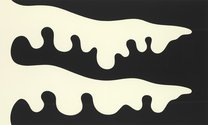John Hurrell – 23 May, 2023
Harris is clever in the way he builds in a poetically ambiguous dimension to the juxtaposed images of his carefully thought-out works. Meanings slide around, and unexpectantly twist and flip. A motif's significance changes according to its setting. An elephant's trunk can be a nose, a finger, a cock or a probing mind in its tentative search for truth; a target can be the face of God, the cosmic abyss, an eye, an anus, an ovum, a cave, a vagina or a symbol for desired redemption.
In this fascinating selection of 44 artworks—approx. 70 images—from painter and (virtuoso) printmaker Brent Harris, a Palmerston North boy who moved to Melbourne (on ‘the other side’ of the Tasman) at the start of the eighties to study, we see a wide range of eclectic interests: ranging from early geometric abstraction (absorbing McCahon and Walters) to allusory diagrammatic figuration (that nods to Wesley and Picabia). These unnerving images contain layered meteorological and physiological ambiguities (often initially pinched from Munch, and Jasper Johns’ transmutations of Picasso) where curiously, terror, anger, shame and humour seamlessly blend.
Whilst mostly avoiding expressive brushmarks in his painting (he works very eloquently with flat-coloured wobbly shape and thin tremulous line), the content of Harris’ imagery is often sexual or religious, witty, highly psychological and emotional. And in terms of interpretation, very layered, psychoanalytical, ambiguous and mentally very slippery. Lots of oscillating meanings are piled up together where the creepy and carnal rub up against the spiritual.
Positioned in the three Chartwell rooms up on Level Two, the works are arranged more thematically (although they are often multi-themed) than chronologically. The paintings are strikingly unusual with their organic amoeboid shapes with impeccable, undulating (never straight) edges. These peculiar flat forms make them highly memorable. Harris is a brilliant designer, as well as builder of symbols and gradual revealer of intimate painful histories. Very personal family narratives (monstrously abusive father and weak ineffectual mother) are schematicised with considerable élan.
Harris is clever in the way he builds in a poetically ambiguous dimension to the juxtaposed images of his carefully thought-out works. Meanings slide around, and unexpectantly twist and flip. A motif’s significance changes according to its setting. An elephant’s trunk can be a nose, a finger, a cock or a probing mind in its tentative search for truth; a target can be the face of God, the cosmic abyss, an eye, an anus, an ovum, a cave, a vagina or a symbol for desired redemption.
What really is gobsmacking is Harris’ inventive treatments of his main family protagonists. The villainous father has a sneering mouth, crinkly eyes and ruffled hair, while the indifferent blonde mother—with smooth flowing hair—has no eyes, nose or mouth at all. As for the suffering artist, he has two ears on the same side of his head, demonstrating his hope for hearing utterances of shame or contrition from his parents.
Another set of highly ambiguous images is found in the Swamp (1999-2000) series of paintings and prints, which feature compositions of meandering and mostly descending dribbles, carefully orchestrated for maximum suggestiveness pertaining to sexual violence. The trickling lines could be ejaculate, drool, ectoplasm, dribbling blood, flayed skin, melting snow dripping from Munch’s fir-trees, copulating figures, blobby ghosts and more.
Another group are the images of mountains Taranaki and Ruapehu, symbols of his mother’s denied breasts, viewed from his Palmerston North rooftop. They might be seen as lickable ice-cream cones with their oozy dripping snowcaps, and not geographical at all. However, my favourite multi-meaninged image is Sad Magdalen (2022), which can be seen as two draped female figures standing in front of and looking into the open tomb, or as a single blue scarfed figure with torrents of tears streaming out of both eyes. It is brilliantly designed.
My second favourite painting is another small work, Monkey Business #6 (The Walk with S.H.) (2022)—a work (see fig. 6) that is quite abstract and extremely elegant. Formally it relates to Joan Miro, and thematically to Sydney Nolan and his painting of Kelly gang member Steve Hart wearing a pretty dress and sitting on a horse, just before the gang’s final fatal confrontation with the constabulary. In Harris’ version Hart’s figure is a patterned vertical oblong with a solitary foot, and he is staring at, on the right, a huge grey one-eyed skull.
This is an impressive show that took me completely by surprise—particularly the post 1994 material. Harris is a sensational evoker of emotion via flat symbolic shape, tremulous edge and quivering line; through these, loading up on linen and paper distressing stories accompanied by discreetly black humour, strived-for truth, and evanescent quicksilver interpretation.
John Hurrell

















 Advertising in this column
Advertising in this column Two Rooms presents a program of residencies and projects
Two Rooms presents a program of residencies and projects



This Discussion has 0 comments.
Comment
Participate
Register to Participate.
Sign in
Sign in to an existing account.